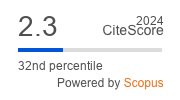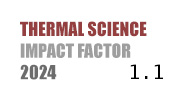THERMAL SCIENCE
International Scientific Journal
COMPARATIVE TEMPERATURE AND CONSUMPTION DATA MEASUREMENT OF MODEL BUILDINGS WITH DIFFERENT THERMAL TIME CONSTANTS
ABSTRACT
In this study, three identically designed model buildings and their heating energy consumption was compared. Those pilot scale buildings are equal by size and were located on the same location. During the measuring campaign both external and internal temperatures were recorded, beside the energy consumption. The model buildings were labeled as A (constant baseline), B (baseline varying according to a time program), and C (unheated, blank). During the measurements, the thermal mass of the buildings was altered. The same amount of thermal mass was installed in all three model buildings during all measurements. According to our results under real weather conditions, the intermittent heating requires less energy than maintaining a constant temperature, and the energy saving is inversely proportional to the time constant at intermittent heating. Instead of specific heat mass, a thermal time constant was used to compare intermittent and constant heating. It was established that as the thermal constant of the model building increases, the energy savings between maintaining a variable base temperature and maintaining a constant base temperature decrease. The expected savings are between 4% and 7%.
KEYWORDS
PAPER SUBMITTED: 2023-06-04
PAPER REVISED: 2023-09-07
PAPER ACCEPTED: 2023-10-02
PUBLISHED ONLINE: 2023-11-11
THERMAL SCIENCE YEAR
2024, VOLUME
28, ISSUE
Issue 2, PAGES [1881 - 1891]
- ***, Council of the European Union, www.consilium.europa.eu/en/policies/climate-change/
- ***, Council of the European Union, www.consilium.europa.eu/en/infographics/fit-for-55-making-buildings-in-the-eu-greener/
- Harish, V. S. K. V., Kumar A., A Review of Modeling and Simulation of Building Energy Systems, Re-newable and Sustainable Energy Reviews, 56 (2016), Apr., pp. 1272-1292
- ***, European Comission, ec.europa.eu/eurostat/databrowser/view/TEN00124/default/ta-ble?lang=en&category=nrg.nrg_quant.nrg_quanta.nrg_bal
- Csoknyai, T., A Magyarországi Lakóépület Állomány Energetikai Elemzése Épülettipológián Alapuló Modellezéssel, (Energy Analysis of the Residential Building Stock in Hungary Based on Building Typol-ogy Modeling - in Hungarien), Ph.D. thesis, Magyar Épületgépészet LXXI, 2022, pp. 3-10
- ***, International Energy agency, www.iea.org/
- ***, Hungarian 7/2006 TNM Energy Efficiency Regulation for Buildings, net.jogtar.hu/jogsza-baly?docid=A0600007.TNM&searchUrl=/gyorskereso?keyword%3D7/2006%2520TNM
- ***, Hungarian Central Statistical Office, www.ksh.hu/stadat_files/ara/hu/ara0044.html
- Alsaffar, A., Alwan, Q. A., Energy Savings in Thermal Insulations for Sustainable Buildings, Journal of Engineering, 20 (2023), 6, pp. 63-76
- Afroz Z., et al., Tuning Approach of Dynamic Control Strategy of Temperature Set-Point for Existing Commercial Buildings, IOP Conference Series: Materials Science and Engineering, 609 (2019), 062029
- Bauman M., Vélemény a szakaszos fűtés energiatakarékosságáról, (Opinion on the Energy Efficiency of Periodic Heating in Water, Gas, Heating Technology, and Cooling - in Hungarian), Víz, Gaz, Futestech-nika es Huto, Klima Legtechnika Szaklap, www.vgfszaklap.hu/lapszamok/2000/november/136-velemeny-a-szakaszos-futes-energiatakarekossagrol, 2000
- ***, International Energy Agency, Playing my part, IEA, Paris (2022) www.iea.org/reports/play-ing-my-part
- Obradovich, N., et al., Nighttime Temperature and Human Sleep Loss in a Changing Climate, Science Advances, 3 (2017), 5, 1601555
- Okamoto-Mizuno, K., Effects of Thermal Environment on Sleep and Circadian Rhythm., J. Physiol. An-thropol., 31 (2012), 14
- Harding, E. C., et al., The Temperature Dependence of Sleep, Front Neurosci, 13 (2019), Apr., pp. 1-16
- Shin, M., et al., The Effects of Fabric for Sleepwear and Bedding on Sleep at Ambient Temperatures of 17 °C and 22 °C, Nature and Science of Sleep, 8 (2016), Apr., pp. 121-131
- Shan, L. et al., Effects of Ambient Temperatures on Sleeping Thermal Comfort and Respiratory Immunity: A Winter Field Study in College Students, Journal of Building Engineering, 52 (2022), 104375
- Lv, X., et al., Energy Consumption Modelling Analysis of Prefabricated Buildings Based on KPCA - WL SSVM, Thermal Science, 26 (2022), 5A, pp. 4031-4042
- Dreau L. J., Heiselberg, P., Energy Flexibility of Residential Buildings Using Short Term Heat Storage in the Thermal Mass, Energy, 111 (2016), Sept., pp. 991-1002
- Liu, Z. Q., et al., Simulation on Building Energy Consumption for a Residential Building, Applied Me-chanics and Materials, 492 (2014), Jan., pp. 143-146
- Clarke, J. A., Energy Simulation is Building Design, Butterworth-Heinemann, Oxford, UK, 1985
- Levermore, G., Time Constants for Understanding Building Dynamics, Journal of Building Services En-gineering Research and Technology, 41 (2019), 3, pp. 234-246
- Li, Y., et al., Thermal Mass Design in Buildings - Heavy or Light?, International Journal of Ventilation, 5 (2016), 1, pp. 143-150
- Nowarski, J., Thermal Time Constatnt - TTC, Zenodo, version 2.1.1, 2022, DOI:10.5281/zenodo.6530723
- Pager, Sz., et al., Creation and Validation of Simplified Mathematical Model for Residential Building Energy Analysis in Matlab Environment, Mechanical Engineering Letters, 22 (2022), pp. 26-41

